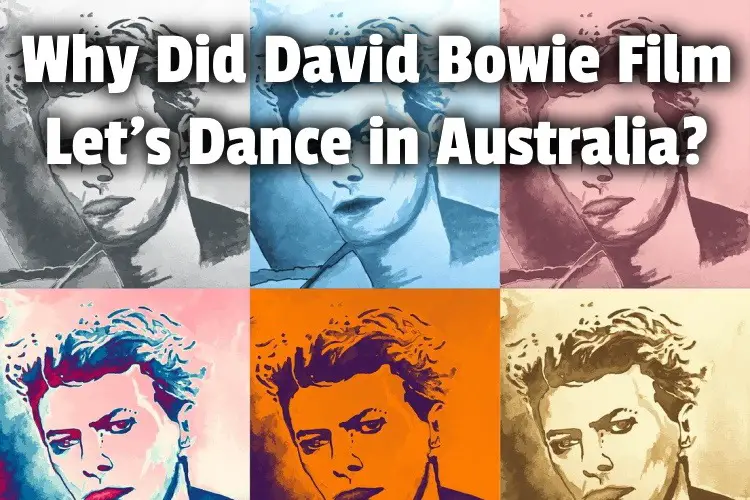
In 1983, David Bowie traveled from London to Carinda, Australia, to shoot a video for the song Let’s Dance. But Why Did David Bowie film Let’s Dance in Australia?
David Bowie shot his 80’s hit classic “Let’s Dance” in Australia as an effort to address the racism towards the Aboriginal people in Australia and tackle it head-on by showing utility.
Bowie told Rolling Stone, “As much as I love Australia, it’s probably one of the most intolerant places in the world, well in line with South Africa.”
Later, a Rubika Shah-directed short documentary, “Let’s Dance: Bowie Down Under”, further explored the divide between whites and Aboriginals in those days.
The documentary reveals one of the crew members from the shoot explaining to music journalist Kurt Loder:
“It was David’s idea to shoot in Australia, which in those days was a bold thing to do for a music video. I don’t think any of us had any idea how important it was to do and what the reaction would be.”
Since shooting in Australia in those days was “quite a risqué” (Matt Coyte), I wondered if the video attracted any legal implications. And why did David go to Carinda in the first place? Would the song have been any less popular if it was shot somewhere else?
Let’s find out.
Now playing : Lets Dance – 2002 Remaster – David Bowie, from the album “Lets Dance” (released in 1983) pic.twitter.com/hkbkQfgHLG
— What’s XGC listening to ? (@XGC_Listening) March 8, 2021
Where in Australia was Let’s Dance filmed?
Bowie’s place of choice to film Let’s Dance was a small town in Australia named Carinda. According to crew members, the place was like the Wild West in those days.
Music journalist Matt Coyte described when Bowie landed in Carinda to shoot his video, it was “like an alien walking down the street”.
Nowadays it’s more about health, safety and musicians don’t travel without representatives of the film company. There is a whole set of execution techniques regarded in music video making.
But in the old days, one would literally be in the street, and then something would hold up the shoot, and then you’d have to start filming again. It was mostly like “guerilla filmmaking”.
It was rare to see Aboriginal people being talked about positively in Australia. However, Bowie’s first-ever attempt to shoot in Carinda shifted this position, bringing him a celebrated title of “responsible artist”.
He refused to cast actors in his video and opted to include real people that were in the bars working late at night.
“You couldn’t pay actors to act the way they looked with these Aboriginals dancing in their bars”-Ross Cameron, Video Producer.
It’s not an exaggeration to say that Bowie’s unconventional move to shoot in Carinda, Australia changed the way music interacted with listeners, which I believe is the true purpose of music.
In 1983, David Bowie travelled from London to the town of Carinda, NSW, Australia, to make the video for “Let’s Dance”. When Bowie landed in Carinda, he said “like an alien was walking on the street” (irony) pic.twitter.com/gFDotFt4A6
— halimsz (@weirdfizh) May 10, 2021
Why did David Bowie go to Carinda?
David Bowie shot Let’s Dance in Carinda as he wanted to bring light to the racism in the country at that time. Another reason was to reflect the memories of “stolen generations”- a term used to describe Aboriginal children taken away by the government and placed into white families.
In his video, David Bowie wanted to insert these direct references to the stolen generation.
One of the most highlighted acts in the video shows a young girl scrubbing the town’s streets, which refers to how Aboriginals were trained from the beginning to be domestic servants.
Video Director David Mallet notes, “this was the genius of David Bowie.” He was bold to pick up an uncomfortable subject and bring out the horrors of a community. And Carinda happened to be just a small figment of those horrors.
The video also sent a message to the people to embrace their culture and be proud of it. They were not spear-wielding tribal people hunting for food; they were like everybody else.
Bowie himself revealed the concept of the video, saying, “it’s a very direct statement about the integration of one culture with another.” In all honesty, the world needs more artists like Bowie.
David Bowie’s secret life in Australia, living in a Sydney apartment for 10 YEARS https://t.co/L9M7yTPakA pic.twitter.com/BEVFXSHtwq
— Daily Mail Australia (@DailyMailAU) January 11, 2016
Was David Bowie Australian?
Originally named David Robert Jones, Bowie was born in London, England, and spent most of his life there. But he did spend approximately 10 years in Sydney, Australia, in the mid-80s up until 1992.
Bowie used his Sydney-based apartment for month-long adventures throughout the 1980s.
The inner suburb situated 3 km to the east of Sydney was an area that sheltered some of the finest homes, including Bowie’s apartment.
During the 1980s, Bowie lived in the residential area known as Kincoppal, where his band Tin Machine recorded their second album.
Bowie traveled around the world, but I guess the dusty and surreal Australian landscape attracted his undivided attention, offering a great background to create the best-selling album of his life, “Let’s Dance”.
david bowie ✨
my favorite song is starman or lets dance 🥺 pic.twitter.com/mx5oyfvgKQ— sassy sadie 🪐✨ (@unfortunateting) October 9, 2019
Was Let’s Dance a protest song?
Let’s Dance, the song, is not a protest song. However, the video for that song is like a sociological commentary on societal issues in general, including racist attitudes and the inability to embrace individual differences.
The reason I said social commentary is because the track, as I mentioned earlier, was an effort to uncover the plight of the Aboriginals in Australia during those days.
If it were a protest song, it would use all sorts of controversial lyrics; it could and would have even gotten banned. But nothing like that ever happened. In any way, music’s purpose is never to protest against anything. But communicate.
It is more like an eye-opening medium to introduce one culture to another. And along with it comes the downsides, whether it is racism being faced by one culture or women objectification by others.
The track produced in collaboration with Nile Rodgers contained a message; “When everything is against you, put on your red shoes and dance the blues”. So, I highly doubt there is anything as nearly as protesting about it.
But did Bowie co-write any other song?
Read my recent article where I have also discussed other songs that became milestones of Bowie’s career that he co-wrote with other artists like John Lennon.
Just click that link to read it on my site.
‘This Is My Country’ – The discrimination against and displacement of aboriginal communities of Western Australia i pic.twitter.com/Pku8d1LGwq
— Earthman Journalist (@Intprofessor) May 17, 2016
Does Australia still treat the indigenous people poorly?
The percentage of discrimination in Australia against indigenous people increased from 28.6% to 52.1% and remains very high at 49.7.
After historical movements like Me Too and Black Lives Matter, researchers at Monash University discovered that discrimination in Australia against Aboriginals had seen a disturbing rise.
The cases, including denying job opportunities to discouraging people from education, remain a cause of concern.
The report was revealed on behalf of Inclusive Australia based on people surveys taken over several years on several measures, including their experience of discrimination and feeling of belongingness.
Conclusion
Hit track from the 1980s Let’s Dance by great musician David Bowie took an unconventional route to music video production and chose the dusty Australian landscape to shoot.
But this move was considered “bold” by video director David Mallet because, in the 1980s, Australia was a common ground for racial intolerance, concentration camps, and prisons.
Bowie felt obligated as an artist to talk about the issue and blended highly politicized scenes to highlight the plight of Australian Aboriginals. The English singer-songwriter took direct references from life and changed how music videos were shot.
To date, Bowie’s music video has inspired thousands of singers and brought them worldwide success.
Image by pascal OHLMANN from Pixabay
